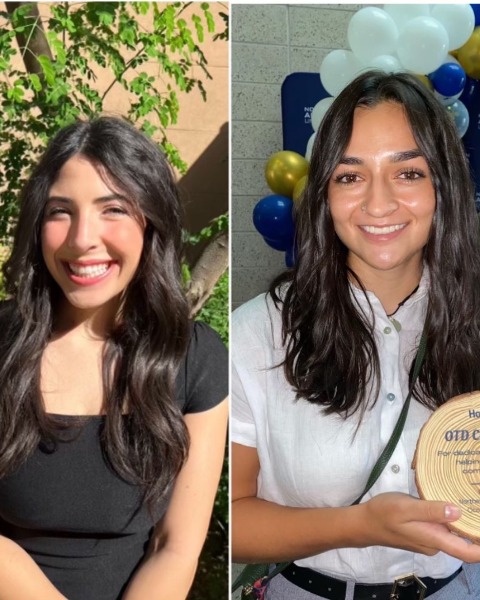Back
There are separate poster presentation times for odd and even posters.
Odd poster #s – first hour
Even poster #s – second hour
Co-authors:
Virtual Posters
Poster: Virtual Posters
Integrating Ultrasound into Anatomy Education for First Year Occupational Therapy Students: Preliminary Results
Friday, March 22, 2024
12:00pm – 7:00pm US EDT
Location: Virtual
There are separate poster presentation times for odd and even posters.
Odd poster #s – first hour
Even poster #s – second hour
Co-authors:
Kianna Vasavilbaso, OTD-S - Doctorate of Occupational Therapy Student, Occupational Therapy, Northern Arizona University; Cindy Ivy, OTD, M-Ed, CHT - Clinical Professor, Occupational Therapy, Northern Arizona University; Anne Titelbaum, PhD - Associate Professor, Basic Medical Sciences, University of Arizona College of Medicine-Phoenix

Jordan R. Gilbank, OTD-S
Doctorate of Occupational Therapy Student
Northern Arizona University
Phoenix, Arizona, United States
Presenting Author(s)
Abstract Body : Ultrasonography (US) is increasingly being added to 1st year anatomy education so students may gain experience using this technology and visualizing 2-D anatomy on living individuals. Introducing Occupational Therapy (OT) students to US is relevant, as US is used in OT practice to visualize structures, monitor changes over time, enhance patient engagement and advance clinical outcomes.
This study explored the value of integrating an US workshop to the context of anatomy for 1st year OT students. It was hypothesized that the workshop would reinforce anatomy content, make the course more relevant for future clinical practice, and that students would benefit from introduction to US during their 1st year, in preparation for their 2nd year studies. Led by an OT who uses US as part of their clinical practice and assisted by 2nd & 3rd year OT students, the workshop included an anatomical review of the carpal tunnel, overview of ultrasound physics and operation, and small group hands-on practice using an US probe to identify the structures of the carpal tunnel in standardized patients. Pre & post surveys were completed to assess their knowledge of US and the carpal tunnel, and the impact of the workshop on student learning. Surveys consisted of 5-point Likert-style questions as well as fields for qualitative feedback. Both surveys had 42 respondents. In addition to increasing awareness of the use of US in OT practice, the Likert scores indicate the students felt they learned something valuable in the workshop (4.71), it helped to reinforce the musculoskeletal anatomy they were learning in the gross lab (4.50), it helped to improve their understanding of the carpal tunnel structures (4.50), and it was a good companion to the gross anatomy course (4.50). The majority of respondents indicated interest in using US in future practice (4.24). Qualitative feedback identified aspects of the workshop that helped students understand and use US, reinforcement of anatomical structures, suggestions for improvement, and expressions of enjoyment of the workshop.
Data from this investigation suggests that introducing an US workshop within anatomy education is beneficial for 1st year OT students. The workshop introduced students to US, reinforced anatomy content, provided clinical relevance for future practice, included the opportunity to learn from a practicing OT, near-peer mentorship, and hands-on active learning.
The next phase of this study will occur in 2024, to assess the impact of the workshop on the students in their 2nd year coursework when they are introduced to US in the context of clinical practice. Surveys will assess if the 1st year workshop prepared the students to use and understand therapeutic US during their 2nd year of study, and if the workshop helped them retain knowledge of carpal tunnel anatomy.
This study explored the value of integrating an US workshop to the context of anatomy for 1st year OT students. It was hypothesized that the workshop would reinforce anatomy content, make the course more relevant for future clinical practice, and that students would benefit from introduction to US during their 1st year, in preparation for their 2nd year studies. Led by an OT who uses US as part of their clinical practice and assisted by 2nd & 3rd year OT students, the workshop included an anatomical review of the carpal tunnel, overview of ultrasound physics and operation, and small group hands-on practice using an US probe to identify the structures of the carpal tunnel in standardized patients. Pre & post surveys were completed to assess their knowledge of US and the carpal tunnel, and the impact of the workshop on student learning. Surveys consisted of 5-point Likert-style questions as well as fields for qualitative feedback. Both surveys had 42 respondents. In addition to increasing awareness of the use of US in OT practice, the Likert scores indicate the students felt they learned something valuable in the workshop (4.71), it helped to reinforce the musculoskeletal anatomy they were learning in the gross lab (4.50), it helped to improve their understanding of the carpal tunnel structures (4.50), and it was a good companion to the gross anatomy course (4.50). The majority of respondents indicated interest in using US in future practice (4.24). Qualitative feedback identified aspects of the workshop that helped students understand and use US, reinforcement of anatomical structures, suggestions for improvement, and expressions of enjoyment of the workshop.
Data from this investigation suggests that introducing an US workshop within anatomy education is beneficial for 1st year OT students. The workshop introduced students to US, reinforced anatomy content, provided clinical relevance for future practice, included the opportunity to learn from a practicing OT, near-peer mentorship, and hands-on active learning.
The next phase of this study will occur in 2024, to assess the impact of the workshop on the students in their 2nd year coursework when they are introduced to US in the context of clinical practice. Surveys will assess if the 1st year workshop prepared the students to use and understand therapeutic US during their 2nd year of study, and if the workshop helped them retain knowledge of carpal tunnel anatomy.

